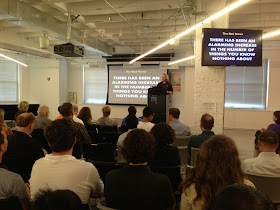With school about to start in Chicago, it's time to consider using mobile technology in the classroom.(Chris Walker, Chicago Tribune / September 10, 2012)
|
As our children go back to school this year, they are entering a broken system. Bureaucrats, policymakers and teachers all have tried to fix the schools. None of the solutions has worked.
As an entrepreneur who has run companies small and large, I know solving this problem isn't about more money. It's about innovation.
President Barack Obama was on the right track when he called for Internet access in all schools. I applaud his focus on digital literacy, but investing billions in infrastructure solves a problem we don't have. Students already have plenty of Internet access. It's in their phones.
We should incorporate mobile devices into everyday learning and stop teaching our children the old-school way. In my visits to Chicago Public Schools, I have seen smartphones in the hands of nearly every kid. If we embrace these devices, we get away from arguing about schools and begin to focus on students. And students, like it or not, are avid consumers of multimedia and electronic content. According to a 2010 Kaiser Family Foundation study, our children are spending more time watching TV, playing video games or surfing the Internet (a total of seven hours and 38 minutes per day) than in school. Let's convert some of those hours into learning time.
The reality is that few kids want to read textbooks today. Nor are textbooks the best way to learn. When you factor in different learning rates, different learning styles and the different languages in our melting pot, along with a fast-changing world, static books no longer make the grade. We can deny this or move forward with real-time curriculum that is easily accessible to all kids on mobile devices.
Here are three ways to make learning mobile:
•Students are locked into learning inside the four walls of a classroom, arriving and leaving at the sound of a bell. Mobile devices can free them to learn on their own time.
A kid struggling in U.S. history, for instance, could take video of the teacher talking, then review it at home to master the subject. If that's not enough, the student could view a different (and maybe better) teacher from an online school. The founder of Sun Microsystems and his wife have created the CK-12 Foundation, a collection of free online textbooks, videos, exercises and flashcards. We should encourage kids to use this electronic library.
As Sal Kahn, an e-learning pioneer, told Forbes magazine, "Now that there are these tools, where students can learn at their own pace and master the concepts before moving on, can we rethink this educational model that has been standard practice for hundreds of years?"
•Smartphones can let students learn in their own way.
A kid embarrassed to ask a question could text a teacher during class. Some schools already are having math teachers send problems to students individually, the first personalized instruction many have ever had. Bright kids get tougher equations to solve so they can speed ahead, while struggling kids get problems they can handle.
Mobile devices can make memorization go down easy. At Carnegie Mellon University, researchers are using a gamelike interactive phone app to teach rural Chinese children English. We could use this in ESL classes in Chicago.
•Teamwork is mandatory now in the workplace. Let's have kids use their phones to work on projects together.
Classmates working on a biology project over the weekend could exchange pictures and ideas. Students even could move beyond their school population for collaboration. Imagine a Chicago science class studying precipitation comparing notes and measurements with South African students studying the Kalahari Desert.
We can only imagine what our children's adulthood will look like and what they can create if they have the tools to do so. It's time to take a cue from our kids and do what they are doing: Put mobile first.
Tullman is managing partner of 7wire Ventures, a Chicago firm that invests in health care, education and energy.

































